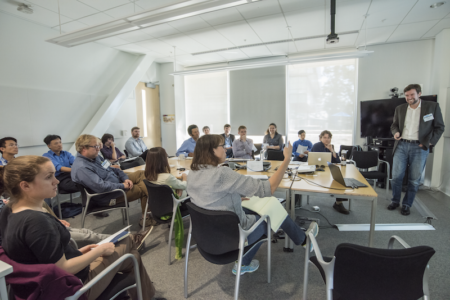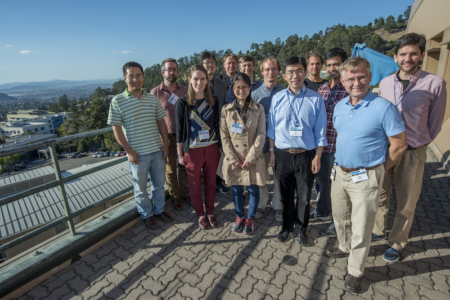The ALS Upgrade Project (ALS-U) took center stage at this year’s ALS User Meeting, beginning with Laboratory Director Mike Witherell’s announcement that ALS-U has received mission-need approval (also known as critical decision zero, or CD-0) from the Department of Energy (DOE), the first critical milestone in the DOE approval process. Several talks and workshops focused on the engineering aspects of the upgrade and science opportunities it will enable.
On the first day, Jesper Andersen, science director of MAX IV Laboratory, provided an update on the status of his facility, currently under commissioning. A key component of MAX IV’s capabilities, which will also be critical to enabling ALS-U’s success, is the multibend achromat (MBA) lattice. MBA lattices enable smaller electron beam sizes by compacting more focusing magnets into a given length. MAX IV employs a seven-bend achromat with 20 periods, and is the first facility to successfully demonstrate the technology— a boon for establishing that the MBA concept so central to ALS-U is sound. MAX IV achieved first light in November 2015, and as of September 2016 obtained its first stored beam in its 1.5 GeV ring. Over its first few years, it hopes to bring 14 beamlines online.

ALS-U Project Director Dave Robin provided a design update on the upgrade, highlighting the aspects that are expected to make ALS-U the world’s highest coherent flux, soft x-ray synchrotron light source. In addition to employing an MBA lattice, ALS-U will make use of an on-axis “swap-out” injection technique with a full-energy accumulator ring. The combination of technologies would allow ALS-U to reach the fundamental diffraction limit up to 2 keV. The project will also include an upgrade of optics on existing beamlines and realignment or relocation of beamlines where necessary as well as the addition of three new undulator beamlines optimized for novel science made possible by the beam’s high soft x-ray coherent flux.
ALS Science Deputy Steve Kevan, who also serves as the science lead for ALS-U, spoke on science opportunities the upgraded facility would provide. Critically, the improved capabilities of ALS-U would enable an unprecedented combination of 3-D, nanometer-scale imaging with chemical, electronic, and magnetic contrast over broad kinetic timescales, with implications for such challenges as understanding the critical roles of heterogeneity, mastering hierarchical architectures, and harnessing coherence in light and matter. Kevan also stressed the importance of ALS user input in developing the science case for ALS-U. He announced a workshop to be held January 18–20, 2017 and the ongoing opportunity for users to provide input by submitting slides proposing early science opportunities and tools needed.

An evening session on the first day comprised three talks by users and staff on ALS-U enabled capabilities and science. Will Chueh from Stanford University detailed his research on better understanding and controlling energy storage mechanisms. For his work, which includes real-time imaging of battery crystals as they charge and discharge, the higher coherent flux of ALS-U would mean dramatically higher spatial and temporal resolution. ALS Experimental Systems Division Deputy Howard Padmore spoke on advances in x-ray interferometry, particularly how new approaches and an upgraded facility would allow for ultrahigh resolution and ultradilute spectroscopy. Oleg Shpyrko of the University of California, San Diego, whose work focuses on x-ray photon correlation spectroscopy (XPCS) of strongly correlated materials detailed his calculations of the capabilities ALS-U would provide for his work. In particular, he predicts ALS-U’s higher coherent flux will result in up to a one-million-fold increase in time resolution. The key challenge will be figuring out how to capture all the photons.
The User Meeting also included a range of topical workshops, several of which discussed ALS-U-relevant science. Among those was “Ordering Phenomena in Functional Complex Oxides,” organized by Elke Arenholz (ALS) and Alexander Grutter (NIST), which focused on scanning soft x-ray spectromicroscopy and scattering techniques that can probe order and function on the micro- and nanoscale and selectively probe phases only found near interfaces in multilayers or in domain walls of periodic domain arrays. The exceptional coherence provided by ALS-U would enable in-depth understanding of ordered phases, phase co-existence, nanoscale heterogeneity, and unique domain wall characteristics in functional complex oxides. Among the workshop participants there was particular enthusiasm for the development of advanced scanning transmission x-ray microscopy (STXM) capabilities employing new detection modes and providing extended sample environments such as high fields, low temperatures, and flexible experimental geometries. Moreover, spatially resolved x-ray ferromagnetic resonance (XFMR) experiments, which, for example, can directly measure spin currents flowing through a nanostructured material, and their combination with interface-sensitive scattering probes were proposed and excitedly discussed.

“Nanotomography of Vector Fields,” organized by Peter Fischer (LBNL’s Materials Sciences Division) and Peter Ercius (Molecular Foundry), brought together experts in theory, experiment, simulation, and computing aspects of vector tomography to provide a snapshot of the current state of the art, as well as gaps that will impact ALS-U science. The ALS has made significant contributions in x-ray tomography of scalar quantities in the past, but vector quantities such as electron spin, and particularly nanoscale characterization of 3-D spin systems are increasingly relevant and require specialized capabilities to measure. The high coherent flux of ALS-U would allow for higher resolution measurements and a new level of understanding of these systems, but workshop participants also emphasized the interdisciplinary efforts needed, particularly engaging with computing and mathematics, to process the vast amount of data the new characterization techniques will produce regularly.
Additional information and resources on ALS-U are available on the ALS website.